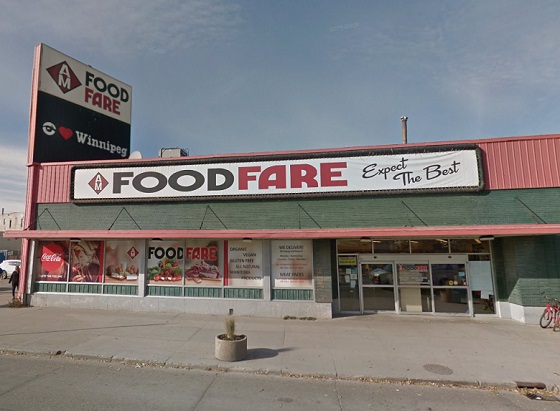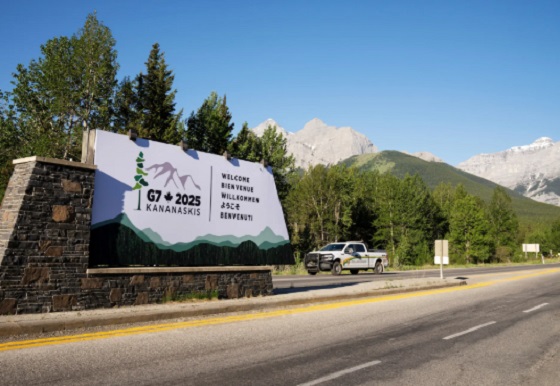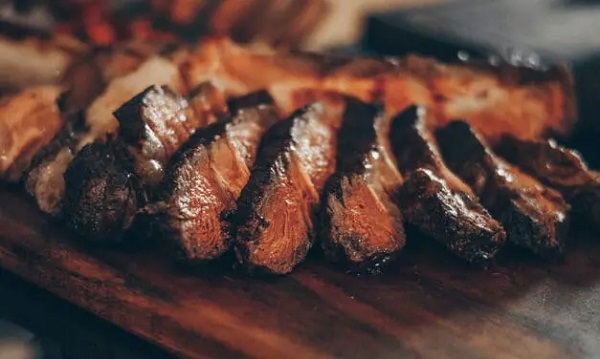Uncategorized
Inner city shoplifting and Manitoba Premier Wab Kinew

From the Frontier Centre for Public Policy
This problem is only made worse by gullible writers and politicians who make excuses for the thieves. Their excuse is that these people are disadvantaged, so they are less than fully responsible for their criminal conduct. Some sympathetic souls go even further, and suggest that these indigenous shoplifters are simply taking back what is rightfully theirs as “reparations” because the shop owners are on “stolen land”.
Winnipeg, Manitoba is being hit with an epidemic of shoplifting that appears to be out of control. Thieves openly steal expensive items, such as frozen meat, from inner city food stores. Shelves are stripped bare in what are more accurately described as robberies than shoplifting. Victims describe brazen thefts by entitled thieves who become indignant when caught in the act. One store employee, who tried to stop a theft, was told “You are on Treaty 1 territory”. The stores that are hardest hit are often owned by immigrant families who have worked very hard to build their modest businesses. Some have had to close, as a result of the unchecked criminality, and others will follow.
Police protection is weak. Even in rare cases where culprits are caught and prosecuted, sentences are minimal.
The problem of brazen theft from Winnipeg liquor stores reached such a serious level in the recent past that customers at urban liquor stores in Manitoba are now allowed to enter the store only after lining up single file, and producing identification. Liquor prices have risen as a result, because special government employees must be hired to sit at the door to inspect ID’s. Customers must line up outside, even on the coldest winter days, because freeloaders choose to steal liquor. And everyone – including the police – are too shy to confront the robbers.
Other western cities, such as Regina, Saskatoon and Thunder Bay are having similar problems. Even small cities, such as Wetaskiwin, Alberta, are hard hit.
The common element is that all of these cities and towns have significant indigenous populations who migrated to the cities from largely dysfunctional reserves, where attitudes of dependency, entitlement and victimhood prevail. Most arrive poorly educated, with few job skills, but with an expectation that they will be provided for. They proceed to live rough lives on the mean streets of these cities. Many drift to shoplifting and other crime. The inner city thieves are disproportionately from this demographic.
This problem is only made worse by gullible writers and politicians who make excuses for the thieves. Their excuse is that these people are disadvantaged, so they are less than fully responsible for their criminal conduct. Some sympathetic souls go even further, and suggest that these indigenous shoplifters are simply taking back what is rightfully theirs as “reparations” because the shop owners are on “stolen land”. They argue that these indigenous people are victims of a system that gives them no chance to succeed, or that they are suffering from the “intergenerational trauma” presumably caused by the fact that 1 in 6 indigenous children attended residential schools in the past.
The shoplifters readily adopt these excuses, and claim to be victims of “systemic racism”.
But, wait a minute! Isn’t the Premier of Manitoba, Wab Kinew, indigenous? Isn’t he a successful, law-abiding person? And wouldn’t most indigenous Canadians laugh at the idea that they had to steal to survive? How is it that Wab Kinew, and the many other successful indigenous Canadians manage their lives just fine while the shoplifters cannot?
The answer is that Wab succeeded the way all successful people do. He went to school, worked hard, and went where the jobs are. He was fortunate to have competent, caring parents who understood the importance of education and hard work. His parents also understood that assimilation (or, if you prefer, integration) was essential for their son to succeed. Wab’s father had a rough time in residential school, but used what he learned to raise a son who has become a provincial premier.
The fact that Kinew is fully assimilated does not prevent him from celebrating his indigenous heritage. Recently, a video of him energetically performing a prairie chicken dance went viral. It showed indigenous youth that they too can be both successful Canadians – and proudly indigenous – at the same time.
It is clear from watching him dancing so vigorously that he would have been a formidable warrior in pre-contact indigenous hunting culture. Colonialism ended that possibility. But it is equally clear that he, and the other indigenous people who were willing to learn the new ways, received a lot in return from the settlers. He is now an articulate, literate, thoroughly modern man, thanks to “settler colonialism”. Colonialism has also given him an expected lifespan more than double that of yesterday’s hunter-gatherers. Colonialism gave at least as much as it took from him.
Kinew’s memoir, “The Reason You Walk” describes someone determined to live his life not as a victim, but as a confident indigenous Canadian.
He built his own life – making mistakes along the way – but learning from those mistakes, and is now the leader of a province – and lauded as a possible future prime minister. He offers no apologies to critics who suggest that an indigenous person who is successful is somehow “selling out” indigenous people. His famous reply to that old saw is “Aboriginal success is the best form of reconciliation”.
Don’t expect to find Wab Kinew stealing frozen hamburger from a Food Fare store anytime soon.
But here’s the lesson indigenous youth can learn from the example Wab Kinew, and other successful indigenous people have set: “If they can do it, so can you”. They should also tell the apologists who want to give them tired excuses – excusing theft as “reparations” for perceived past wrongs, or “intergenerational trauma” – that they, like Wab, refuse to live their lives as “victims”.
In short, the solution to the shoplifting problem is not to condone theft. It is not to treat criminals differently because they are indigenous. It is not to offer them excuses. The solution is to create more Wab Kinews.
And that’s up to Indigenous parents. No government can do that for them. For many families, like Wab’s, that will include the difficult decision to move from dead-end reserves. But if they have the same commitment to their children’s education and upbringing that Wab’s parents had there is no reason that they can’t raise successful children in this country.
Long before he became Manitoba’s premier, Wab Kinew, regularly entertained listeners on CBC Radio. He was a refreshing, common sense voice, and always refused to play the victim. He never failed to remind young indigenous people that Canada worked just fine for him.
And, with a bit of grit and hard work, it can work for them too.
Brian Giesbrecht, retired judge, is a Senior Fellow at the Frontier Centre for Public Policy.
Uncategorized
Kananaskis G7 meeting the right setting for U.S. and Canada to reassert energy ties


Energy security, resilience and affordability have long been protected by a continentally integrated energy sector.
The G7 summit in Kananaskis, Alberta, offers a key platform to reassert how North American energy cooperation has made the U.S. and Canada stronger, according to a joint statement from The Heritage Foundation, the foremost American conservative think tank, and MEI, a pan-Canadian research and educational policy organization.
“Energy cooperation between Canada, Mexico and the United States is vital for the Western World’s energy security,” says Diana Furchtgott-Roth, director of the Center for Energy, Climate and Environment and the Herbert and Joyce Morgan Fellow at the Heritage Foundation, and one of America’s most prominent energy experts. “Both President Trump and Prime Minister Carney share energy as a key priority for their respective administrations.
She added, “The G7 should embrace energy abundance by cooperating and committing to a rapid expansion of energy infrastructure. Members should commit to streamlined permitting, including a one-stop shop permitting and environmental review process, to unleash the capital investment necessary to make energy abundance a reality.”
North America’s energy industry is continentally integrated, benefitting from a blend of U.S. light crude oil and Mexican and Canadian heavy crude oil that keeps the continent’s refineries running smoothly.
Each day, Canada exports 2.8 million barrels of oil to the United States.
These get refined into gasoline, diesel and other higher value-added products that furnish the U.S. market with reliable and affordable energy, as well as exported to other countries, including some 780,000 barrels per day of finished products that get exported to Canada and 1.08 million barrels per day to Mexico.
A similar situation occurs with natural gas, where Canada ships 8.7 billion cubic feet of natural gas per day to the United States through a continental network of pipelines.
This gets consumed by U.S. households, as well as transformed into liquefied natural gas products, of which the United States exports 11.5 billion cubic feet per day, mostly from ports in Louisiana, Texas and Maryland.
“The abundance and complementarity of Canada and the United States’ energy resources have made both nations more prosperous and more secure in their supply,” says Daniel Dufort, president and CEO of the MEI. “Both countries stand to reduce dependence on Chinese and Russian energy by expanding their pipeline networks – the United States to the East and Canada to the West – to supply their European and Asian allies in an increasingly turbulent world.”
Under this scenario, Europe would buy more high-value light oil from the U.S., whose domestic needs would be back-stopped by lower-priced heavy oil imports from Canada, whereas Asia would consume more LNG from Canada, diminishing China and Russia’s economic and strategic leverage over it.
* * *
The MEI is an independent public policy think tank with offices in Montreal, Ottawa, and Calgary. Through its publications, media appearances, and advisory services to policymakers, the MEI stimulates public policy debate and reforms based on sound economics and entrepreneurship.
As the nation’s largest, most broadly supported conservative research and educational institution, The Heritage Foundation has been leading the American conservative movement since our founding in 1973. The Heritage Foundation reaches more than 10 million members, advocates, and concerned Americans every day with information on critical issues facing America.
Business
Beef is becoming a luxury item in Canada

This article supplied by Troy Media.
 By Sylvain Charlebois
By Sylvain Charlebois
Canadian beef prices have surged due to a shrinking cattle herd, high transportation costs, and potential market collusion
With summer weather settling in, Canadians are returning to a familiar ritual—ring up the barbecue. But as they approach the meat counter, many are faced with shockingly high prices. This year, the meat aisle has become a case study in supply-side economics and market dysfunction, leaving
consumers to wonder how this all came to be.
Since January, according to Statistics Canada, beef prices have surged dramatically. Striploin is up 34.2 per cent, top sirloin 33.7 per cent, and rib cuts nearly 12 per cent. Pork rib cuts and chicken breasts have each risen 5.9 per cent, while even meatless burger patties are 6.8 per cent more
expensive. Beef has led the way in these increases, and its dominance in the price hikes is striking. What’s particularly concerning is that it’s not just one cut of beef—virtually every option has seen a dramatic jump, putting pressure on Canadian consumers who were already grappling with rising food costs.
The cause behind these increases lies in Canada’s shrinking beef cow inventory, now at just 3.38 million head—the lowest since 1989. This represents a 1.2 per cent drop from last year, but it signals much more than a cyclical decline. Many cattle producers, facing an increasingly volatile market, are choosing to exit the industry while prices are favourable. Others are opting to reinvest in less risky sectors or even shift entirely to crop production, leaving the beef industry in a precarious state. In short, Canada’s beef industry is retreating, and with that retreat comes rising prices, fewer available cattle, and growing uncertainty.
South of the border, the U.S. is seeing a similar trend, but far less severe. According to the United States Department of Agriculture, the
American beef cow herd declined by just 0.5 per cent to 27.9 million head. This relatively modest drop, coupled with less disruption in their production practices, has resulted in more stable prices.
Over the past year, U.S. boneless sirloin steak rose 5.7 per cent, compared to a staggering 22 per cent in Canada. Ground beef saw a 10.8 per cent increase in the U.S., but 23 per cent in Canada. The price difference between the two countries is stark, and Canadians are feeling the inflationary pressure much more acutely.
There are several factors contributing to the price hikes: Canada’s vast geography, high transportation costs, a limited number of federally licensed beef processors, carbon pricing, and higher labour costs. Carbon pricing, in particular, has added a burden to sectors like beef production, where transportation costs are high. Regulations and logistical inefficiencies add to the costs, driving up prices for retailers and, ultimately, consumers.
This combination of factors is having a compounding effect on the price of beef, making it increasingly out of reach for many.
But there’s another possibility we can’t ignore: potential collusion within the industry. In Canada, a small number of large processors control much of the beef supply, which gives them significant influence over prices. The U.S. government has taken strong action against price-fixing among major meat packers like JBS, Tyson Foods, Cargill, and National Beef, leading to multimillion-dollar settlements. In Canada, however, the Competition Bureau has remained largely silent on similar concerns, allowing the possibility of price-fixing to persist unchecked. Perhaps it’s time for Canada to follow the U.S. lead and ensure the beef industry is held accountable for its actions.
The consequences of these rising costs are already evident. According to IBISWorld, Canadian per capita beef consumption fell by 7.1 per cent in 2023 and is expected to drop another 2.1 per cent in 2024. This isn’t merely a shift in dietary preferences—this is a structural change in consumer behaviour. Beef is becoming increasingly viewed as a luxury item, with many budget-conscious households turning to ground beef as a more affordable option. For many Canadians, beef is no longer a staple food but rather an occasional indulgence, reserved for special occasions or holiday meals.
This shift is unfortunate. Beef remains one of the most natural, sustainable sources of protein available to Canadians. Ranchers and processors have made significant strides in improving environmental stewardship, animal welfare, and food safety, often without recognition. Beef is not only nutritionally dense but also supports rural economies and provides a level of traceability few other protein sources can offer.
For many Canadian families, a summer steak on the grill is becoming more of a splurge than a staple. While Canadians will continue to enjoy beef, the frequency and volume of consumption will likely diminish.
Barbecue season hasn’t disappeared, but for many, it’s starting to look a little different: more sausages, more chicken, and fewer striploins. A shame, really, for a product that offers so much more than just taste.
Dr. Sylvain Charlebois is a Canadian professor and researcher in food distribution and policy. He is senior director of the Agri-Food Analytics Lab at Dalhousie University and co-host of The Food Professor Podcast. He is frequently cited in the media for his insights on food prices, agricultural trends, and the global food supply chain.
Troy Media empowers Canadian community news outlets by providing independent, insightful analysis and commentary. Our mission is to support local media in helping Canadians stay informed and engaged by delivering reliable content that strengthens community connections and deepens understanding across the country.
-

 Bruce Dowbiggin2 days ago
Bruce Dowbiggin2 days agoThe Covid 19 Disaster: When Do We Get The Apologies?
-

 Crime1 day ago
Crime1 day agoSweeping Boston Indictment Points to Vast Chinese Narco-Smuggling and Illegal Alien Labor Plot via Mexican Border
-

 Alberta2 days ago
Alberta2 days agoAlberta school boards required to meet new standards for school library materials with regard to sexual content
-

 International22 hours ago
International22 hours agoSupport for the Ukraine war continues because no one elected is actually in charge.
-

 Business22 hours ago
Business22 hours agoTrump slaps Brazil with tariffs over social media censorship
-

 Environment1 day ago
Environment1 day agoEPA releases report on chemtrails, climate manipulation
-

 Business1 day ago
Business1 day agoCBC six-figure salaries soar
-

 Addictions24 hours ago
Addictions24 hours agoCan addiction be predicted—and prevented?



